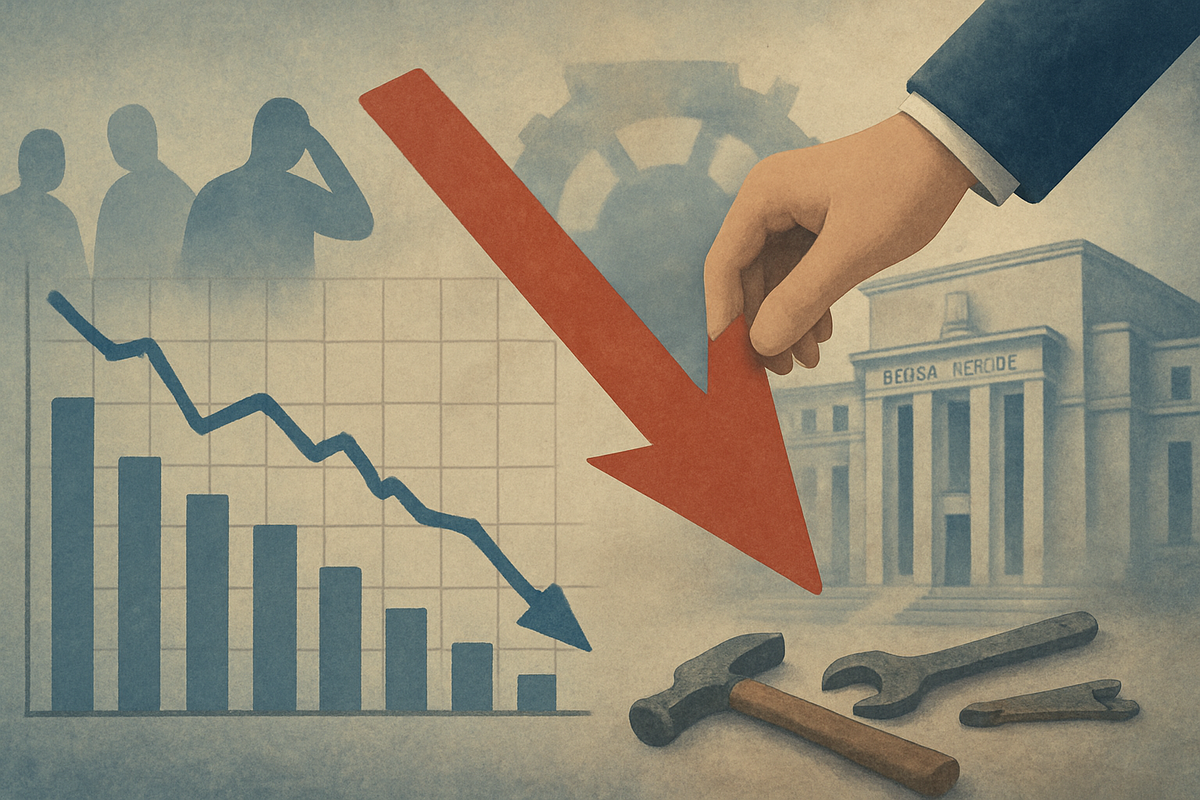
Washington D.C. – October 17, 2025 – The U.S. economy is navigating a period of profound uncertainty as significant downward revisions to August's monthly payroll estimates reveal a far weaker labor market than previously understood. This stark reality has solidified market expectations for aggressive Federal Reserve interest rate cuts, with policymakers now firmly focused on averting a deeper economic slowdown even as inflation lingers above target. The revised data paints a sobering picture, compelling the Fed to prioritize employment stability and signaling a pivotal shift in monetary policy that will reverberate across industries and financial markets.
The immediate implication of these revisions is a reinforced conviction that the Federal Reserve will continue its easing cycle. Having already initiated a quarter-point rate cut in September, markets are now almost certain of another similar reduction at the upcoming October 28-29 Federal Open Market Committee (FOMC) meeting. This dovish pivot underscores the central bank's growing concern that the economy's primary risk has shifted from persistent inflation to a rapidly decelerating, and potentially contracting, labor market. Businesses and consumers alike are bracing for a period of slower growth, with the cost of borrowing set to fall further, influencing investment decisions and spending patterns across the nation.
A Deep Dive into the Labor Market's Unexpected Downturn
The latest jobs report for August 2025 sent shockwaves through the financial community, revealing that nonfarm payrolls increased by a meager 22,000 jobs, dramatically missing consensus estimates that had ranged from 75,000 to 110,000. This marked the fourth consecutive month of job growth below 100,000, signifying the weakest streak since the 2020 pandemic. However, the true alarm bells were rung by the substantial downward revisions to prior months' data. June's payroll change was revised from an initial gain of 148,000 to a net loss of 13,000, while May's job creation was slashed from 144,000 to just 19,000. These revisions alone accounted for a staggering 258,000 fewer jobs over May and June, representing the largest two-month revision on record outside of April 2020.
Adding to the gravity, a preliminary estimate for the benchmark revision for April 2024 through March 2025 indicated that the level of payrolls for March was over 900,000 lower than initially reported, with about 75,000 fewer jobs added per month during that period than previously believed. The average monthly payroll gains over the four months leading up to August averaged only 27,000 jobs, painting a clear picture of the weakest pace of job creation since the height of the pandemic. Further underscoring the weakening labor market, the unemployment rate in August edged up to 4.3%, its highest level since late 2021.
This significant deterioration in labor market data has been the primary catalyst for the Federal Reserve's recent policy shift. Policymakers, including Governor Christopher Waller, have publicly supported future interest rate cuts, with Waller anticipating additional cuts over the next three to six months driven by incoming data. The Fed's subsequent quarter-point interest rate cut in September was largely attributed to this pronounced labor market weakness, as the central bank pivoted its focus towards the "maximum employment" side of its dual mandate. Financial markets have reacted swiftly, with the CME FedWatch Tool projecting a 97% chance of an interest rate cut to below 4% at the upcoming October 29 FOMC meeting, and bond markets reflecting increased confidence in multiple rate cuts by year-end and into 2026.
Corporate Fortunes: Who Wins and Loses from Cheaper Money?
The anticipated Federal Reserve interest rate cuts are poised to create a distinct bifurcation in corporate fortunes, rewarding some sectors while challenging others. Companies with significant debt burdens and those highly sensitive to borrowing costs are generally expected to be the primary beneficiaries.
Growth Stocks and Technology Sector are likely to be among the biggest winners. Companies like Microsoft (MSFT), NVIDIA (NVDA), Apple (AAPL), and Amazon (AMZN), which rely on external funding for rapid expansion and research and development, will find capital cheaper and more accessible. Lower discount rates will also boost the present value of their long-term future earnings, supporting higher valuations. Similarly, Real Estate and Homebuilders such as Pultegroup (PHM), D.R. Horton (DHI), and Lennar (LEN) are set to benefit from reduced mortgage rates, stimulating homebuyer demand and making new construction projects more affordable to finance. Companies like Caterpillar (CAT), involved in construction equipment, could also see increased demand.
Utilities and other capital-intensive industries, which typically carry substantial debt for infrastructure projects, will see their interest expenses reduced, enhancing profitability. NextEra Energy and debt-laden companies like AT&T (NYSE: T) are well-positioned. Highly leveraged companies, such as Six Flags Entertainment (FUN), with substantial annual interest expenses, could see a significant boost to their bottom line. In the Consumer Discretionary sector, PayPal (PYPL) is cited as a potential beneficiary from increased consumer spending and higher payment volumes, assuming a weakening labor market doesn't severely dampen consumer confidence. While the broader financial sector faces mixed impacts, certain institutions like Goldman Sachs (GS) could benefit from stimulated capital market activity, and First Horizon National (FHN) might see increased demand for business and consumer loans. Synchrony Financial (SYF) could also see improved margins.
Conversely, savers and fixed-income investors will experience reduced returns on savings accounts, Certificates of Deposit (CDs), and money market accounts. Banks and diversified financials could face challenges from Net Interest Margin (NIM) compression, where the interest they earn on loans decreases faster than what they pay on deposits, impacting profitability. The financial sector (represented by ETFs like XLF) has historically underperformed in the months following rate cuts. While utilities benefit from lower borrowing costs, their appeal as "bond-proxies" might diminish if bond yields also fall significantly, potentially leading investors to rotate into higher-growth opportunities. The overarching concern of a weakening labor market could temper the enthusiasm for consumer-facing businesses, as job losses and reduced wage growth may erode overall purchasing power despite cheaper credit.
A Broader Economic Rebalancing Act
The current economic juncture, marked by substantial payroll revisions and an aggressive Fed pivot, signals a significant rebalancing act for the U.S. economy, fitting into broader trends of decelerating growth and persistent, albeit contained, inflation. The magnitude of the downward payroll revisions is particularly striking, with the July 2025 report's cumulative -258,000 jobs for May and June being a statistically unusual event, nearly three standard deviations below the historical mean. Such extreme revisions often cluster around periods of major economic stress, raising concerns about the true underlying health of the economy and suggesting the Federal Reserve may have been "flying blind" on labor market conditions.
This shift has significant ripple effects. Lower borrowing costs will generally invigorate investment and expansion across businesses, potentially boosting deal activity in mergers and acquisitions, IPOs, and dividend recapitalizations. However, the economic slowdown is projected to continue, with S&P Global Ratings forecasting 1.9% GDP growth in 2025 and 1.8% in 2026. J.P. Morgan anticipates even lower growth of 1.0% in Q3 and 0.5% in Q4 2025, attributed to lingering policy uncertainty and higher tariffs. While AI investments are a notable tailwind, fueling a surge in technology stocks, their long-term impact on the labor market is viewed more as job transformation than outright elimination.
Beyond interest rates, several regulatory and policy implications are at play. The ongoing government shutdown has delayed crucial economic data, further obscuring the economic picture. Volatile trade policies, particularly the current administration's tariffs, are expected to push inflation higher, complicating the Fed's dual mandate and acting as a headwind to consumer spending. There are also concerns about the politicization of economic data and potential attempts to influence the Federal Reserve's independence, which could erode confidence in economic reporting. Historically, significant downward revisions to payroll data have often been indicative of labor market turning points, similar to those seen during the Great Recession of 2008-2009. The Fed's current "risk management cuts" echo past strategies employed to preempt deeper economic downturns, with a direct parallel to September 2024, when an even larger payroll revision prompted a 50-basis-point rate cut.
Navigating the Path Ahead: Scenarios and Strategic Shifts
The coming months and years will demand strategic pivots from businesses and investors as the U.S. economy adjusts to slower growth, a softening labor market, and a more accommodative monetary policy. In the short term (next 6-12 months), slower economic growth and a continued rise in the unemployment rate, potentially reaching 4.5% by year-end 2025, are anticipated. While easing financial conditions from lower rates will provide some stimulus, market volatility may persist due to the potential disconnect between the Fed's cautious guidance and the market's aggressive rate-cut expectations.
For businesses, the immediate focus will be on cost management and operational efficiency amidst slowing demand and tariff-induced margin pressures. Strategic hiring and investment will likely remain restrained, though AI-related investments are expected to remain strong. Diversifying supply chains to mitigate tariff risks and leveraging lower interest rates to refinance debt or secure new financing will be crucial. Investors, meanwhile, should reassess asset allocation, with bonds remaining attractive as a diversifier against recession risk. Equity strategies might favor large-cap stocks over small caps in an environment of slowing growth, and alternative investments could help manage volatility.
Looking long-term (1-5 years), the economy is expected to experience below-trend growth, potentially recovering in the housing sector as mortgage rates fall further. A "massive surge" in AI investments is projected to be a significant tailwind, propelling growth into 2026 and beyond. However, the full effects of tariffs are expected to weigh on real GDP growth and consumer spending through late 2025 and early 2026. Fiscal policy, potentially turning expansionary with increased spending and tax cuts, could offer an additional tailwind.
Several scenarios could unfold. The Soft Landing (baseline) anticipates a gradual slowdown allowing the Fed to cut rates without a recession, leading to sustained, albeit slower, growth. A Mild Recession is a heightened risk, especially if the labor market loses more momentum, forcing the Fed to cut rates more aggressively. A Stagflation (downside) scenario, where tariffs lead to higher inflation even as the Fed cuts rates, could result in a policy mistake, forcing the Fed to reverse course. Less likely is an Economic Outperformance scenario driven by a surge in productivity. Businesses and investors must remain agile, adapt to the lower interest rate environment, and carefully monitor incoming economic data to navigate these evolving scenarios.
Wrapping Up: A Market in Transition
The significant downward revisions to August's payroll estimates have served as a stark wake-up call, revealing a U.S. labor market that has cooled far more rapidly than initial data suggested. This fundamental shift has compelled the Federal Reserve to accelerate its dovish pivot, with interest rate cuts now a central pillar of its strategy to support employment and prevent a deeper economic downturn. The market is clearly in transition, moving from an era of aggressive inflation-fighting to one focused on managing a slowing economy.
Key takeaways include the undeniable evidence of a weakening labor market, the Fed's unwavering commitment to supporting employment through rate cuts, and the mixed outlook for corporate America. While growth stocks, highly leveraged companies, and the real estate sector stand to benefit from cheaper capital, banks face margin compression, and savers will see diminished returns. The wider significance underscores an economy grappling with decelerating growth, the complexities of tariff-induced inflation, and the transformative potential of AI.
Moving forward, investors should remain vigilant, closely monitoring not only the Fed's actions but also the underlying economic data, particularly labor market indicators and inflation trends. The interplay between monetary easing and the broader economic health, especially the trajectory of the labor market, will dictate the ultimate path of the economy. Businesses, too, must adapt with agility, focusing on efficiency, strategic investment, and prudent debt management. The coming months will be crucial in determining whether the Fed's proactive measures can orchestrate a soft landing or if the U.S. economy is headed for a more challenging period of adjustment.
This content is intended for informational purposes only and is not financial advice





